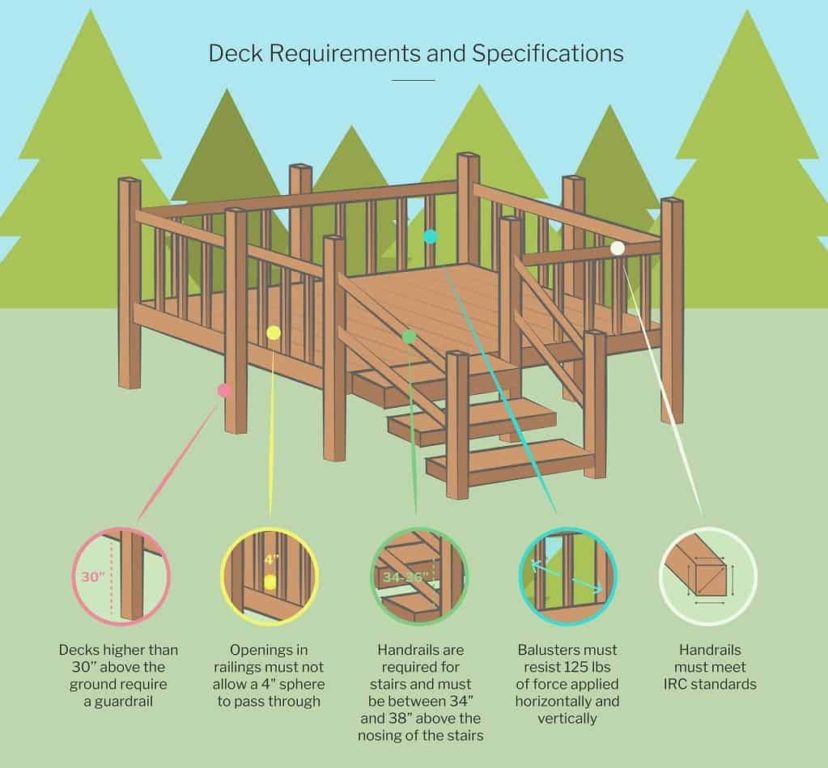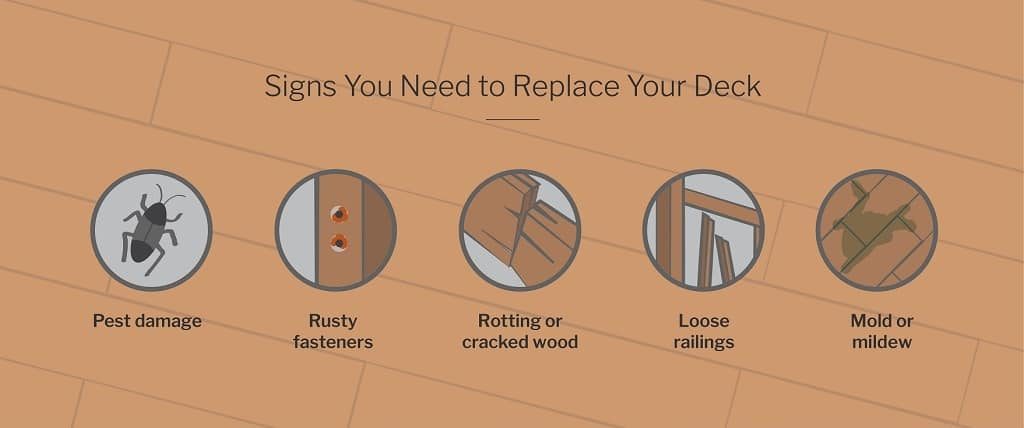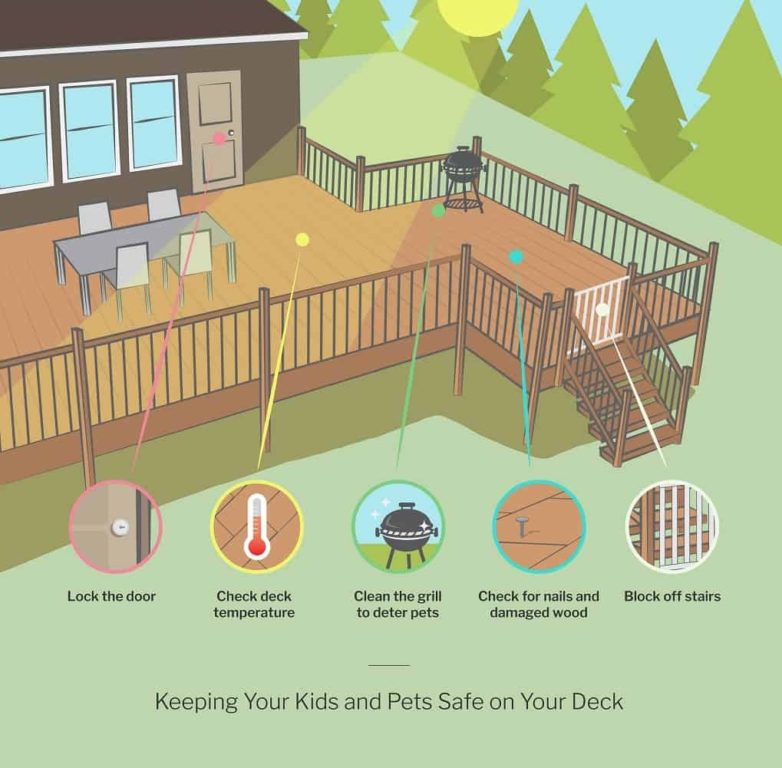
Your deck is your home’s outdoor activity hub when the weather’s nice – you use it for entertaining, relaxing, cooking and more. The problem? It’s outside, and it’s under constant attack from the elements. And according to the Consumer Product Safety Commission, an average of 45,000 people per year are injured as a result of a faulty, damaged or old deck.
So, is your deck still safe?
Today we’re giving you the ultimate deck safety guide complete with safety codes, signs you need to replace your deck, keeping your pets and kids safe, plus an infographic!
Section 1: Safety Codes for Deck Railings, Stairs and More
Section 2: 5 Signs That You Need to Replace Your Deck
Section 3: How to Keep Kids and Pets Safe on Your Deck
Section 4: How to Protect Your Deck from Outdoor Living Accessories
Section 5: How to Protect Your Deck during Inclement Weather
Section 6: The Ultimate Deck Safety Guide Infographic
Safety Codes for Deck Railings, Stairs and More
Your city or township may have additional safety codes for deck railings, stairs and more, but here are some general rules to begin with:
- Any deck that’s higher than 30 inches above grade has to have a guard rail. If you do have a guard rail, the rules of the International Residential Code, or IRC, requires it to be at least 36 inches high.
Other general codes to remember:
- Openings in railings must be small enough that a 4-inch sphere can’t pass through, with the exception of the space between stair risers, stair treads and bottom railings (that can be up to 6 inches).
- Handrails for stairs are always required and must meet the standards outlined in 5.6.3 from the IRC, and the top edge of the handrail has to be between 34 and 38 inches above the nosing on stair treads.
- Railing systems have to feature balusters that can resist 125 pounds of force applied horizontally or vertically (as measured in a 1-square-foot area).

5 Signs That You Need to Replace Your Deck
Over time, your deck and its components are subject to wear-and-tear. With a little bit of sleuthing on your part, you can figure out where to make repairs (or, if you need to, replace the whole thing).
1. Pest Damage
Most new decks are made from treated wood to keep pests away, but those built before the 1980s weren’t. Even with anti-pest treatments, carpenter ants and termites can work their way into the spots where your deck attaches to your house (house materials aren’t typically treated with pest-resistant chemicals); that can cause your deck to pull away from your home, and that’s a major safety hazard.
How to tell if you have pest damage:
- Your deck moves when you first step on it.
- You see holes, piles of sawdust or pests on or beneath your deck.
- Parts of your deck look decayed while others don’t.
2. Rusty Connectors and Fasteners
Many new decks feature fasteners and connectors made from tough galvanized steel, but even those need frequent inspection. Rusty connectors and fasteners can snap and cause an accident. It’s also important to be aware of the environment you live in because some locations, namely coastal locations like Miami or Gold Beach, cause fasteners to rust more quickly.
How to tell if your deck has rusty connectors or fasteners:
- Check the nails on top of your deck first; if you see rust on top, you’re likely to see it beneath the deck, too.
- Examine the underside of your deck with a flashlight, looking at connecting hardware on joists and beams.
- Take a look at the lag screws attaching the ledger, which is the framing material that attaches your deck to your house.
3. Rotting or Cracked Wood
Most wood splits over time, but there’s a difference between tiny cracks and big ones. If you see a crack that’s growing, or if you notice cracks around fasteners, your deck may be weakening. In colder climates, water can get into small cracks, freeze and expand to make cracks even bigger.
How to tell if cracks are dangerous or if wood is rotting:
- If you see a small patch of rot, it’s worth calling in a professional to check it out because it can spread
- Look for cracks larger than a dollar bill, or any cracks near fasteners.
- Watch for scaly patches on wood, or wood that’s splintering off in areas of discoloration – both are signs of rot.
4. Loose Railings
Deck railing needs to hold fast when someone leans against it – and if it doesn’t, a disaster could be right around the corner. While you shouldn’t push anything against your stair or deck railing, it shouldn’t sway or move noticeably when you apply pressure.
How to tell if your railings are loose:
- Any wobbling or swaying is a signal it’s time to call a pro for help.
- Grasp the railing with your hand and push it away from you, then pull it toward you; if you feel more than a little movement, your railing could be dangerously loose.
5. Mold or Mildew Growth
Mold can eat away at your deck, and if you see it on the surface, there could be bigger problems lurking inside the wood. Additionally, stairs and the deck’s surface can become slippery with mold or mildew, which drastically increases your chances of falling.
How to tell if you have mold or mildew growth:
- Check for a green tinge on your planks. While this usually isn’t a problem, it’s something to watch; you can usually clean it away with bleach and water, but if it sticks around, seek professional help.
- Look for fuzzy mold or mushroom growth. Either of these is a sure sign that you have a big problem that needs immediate attention.

How to Keep Kids and Pets Safe on Your Deck
Kids only belong on decks with adult supervision, so lock the door that leads out – and make sure the lock is higher than a small child can reach. Keep an eye on pets too who need supervision as well!
Ways to keep your kids and pets safe on the deck:
- Block off the stairs with a child-proof gate.
- Keep pets safe by not using decorative plants that are toxic.
- Check for standing water; anything more than 2 inches deep poses a drowning hazard for small children.
- Test your deck’s temperature by placing the back of your hand on it for five seconds; if it’s too hot for you, it’s too hot for your pet’s paws.
- Get down on your hands and knees and look for splinters, raised nails and other hazards that you won’t see when you’re standing.
- Clean the grease trap on your grill and make sure pets can’t get to it, and supervise a hot grill at all times.

How to Protect Your Deck From Outdoor Living Accessories
Outdoor furniture accessories instantly make your deck inviting and comfortable. Be aware there are a few things to keep in mind to maintain your deck.
Protect your deck with these tips:
- Don’t drag your outdoor furniture around the deck; you risk damaging the wood, and small scratches can lead to big problems.
- Add glides beneath your furniture’s feet to protect the wood, and don’t rest any furniture against the railing – that can weaken connections over time.
- Never use furniture that’s too heavy, either, which can compromise safety across the whole deck.
- Place water-capturing plates beneath plants to prevent rot, and direct rainwater or gutter runoff away from the deck and its supports, too.
How to Protect Your Deck During Inclement Weather
Lots of sun, rain, snow or wind can take a toll on your deck, and depending on where you live, it’s subjected to all kinds of inclement weather.
Use these tips to keep your deck in good condition during any season:
- Keep your deck’s surfaces clean and apply a water-repelling finish as often as you need to.
- Sweep away leaves frequently, which can rot if they’re left unattended, and clear away snow with a snow blower rather than a shovel, which can damage the wood.
- In bad weather, bring your furniture indoors (or move it off the deck) to prevent wind from slamming it into your deck railings or knocking it over.
These deck safety tips can keep you, your kids and your pets safe, and they’ll keep your entire outdoor living space in great shape for years of enjoyment.
Article provided by Redfin
